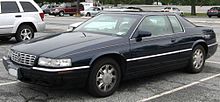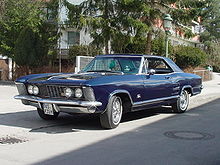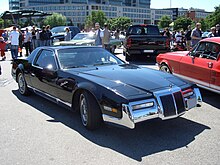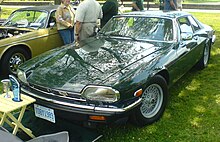Personal Luxury Cars
Personal Luxury Cars is an outdated, but imprecise classification of certain car models that has been used for a long time , especially in the USA . This usually refers to two-door, coupé-like vehicles (rarely also convertibles) with four to six seats and a shape that stands out as clearly as possible from the other models of the respective manufacturer. Initially, individual front seats with a center console were part of the equipment. The term is usually used for US vehicles, but in principle also applies to a number of European and Japanese automobiles.
Furthermore, Personal Luxury Cars cannot be assigned to a specific price class and are technically closely based on the volume models in order to save manufacturing and development costs or existing resources such as B. to better use engines, doors and other components (sometimes even entire floor assemblies) or windows. Personal Luxury Cars often had a shorter wheelbase and larger overhang with a slightly shorter overall length.
Personnel should suggest that these vehicles are specially adapted to the “personal” wishes and needs of the owner - whereby the manufacturer had very clear ideas of what the customer wanted. Personal Luxury Cars were most popular in the second half of the 1960s to the late 1970s.
origin
In contrast to the concept of the Gran Turismo or Sports Coupé , for example , Personal Luxury Cars focused more on luxurious equipment than sportiness, although the choice of the corresponding options made the vehicle a muscle car .
Even before this name came up, there were individualized vehicles based on a similar concept. Examples are among the many custom bodies by specialist firms about the first Lincoln Continental (1940-1948) or the Victoria Convertible of Darrin , available in Packard -Baureihen 120 and 180 . All appeared in the manufacturers' sales catalogs. The quartet of Dream Cars from 1953, Cadillac Eldorado , Buick Skylark , Oldsmobile Fiesta and Packard Caribbean also met the requirements that are commonly placed in this category. While Fiesta and Skylark disappeared after a short time, Caribbean and Eldorado stayed in the program for a while. Later there were also coupés of both, the Eldorado was expanded into its own model series. Its new edition in 1967 is a typical Personal Luxury Car .
Chrysler brought out the C-300 in 1955 , but it was sporty enough to qualify as one of the few US Gran Turismo models. In the following year, Ford doubled with the grandiose Continental Mark II, for which a brand was even created. The Studebaker Hawk is an example of the versatile application of the personal idea; depending on the customer's wishes, it was an elegant everyday car, a sporty coupé for the wife or a brutal muscle car . Examples of early, smaller Personal Luxury Cars are the Hudson Italia or the Nash Palm Beach . However, these vehicles were rarely referred to as personal luxury cars in their time .
development
The term Personal Luxury Car came into use after the introduction of the Ford Thunderbird in 1954 (Ford referred to the two-seater as a personal car because, according to the ideas of the time, it did not actually represent a sports car with its comfort-oriented equipment and soft chassis ), but especially after the presentation of the four-seater Thunderbird in model year 1958. Whether a convertible coupe was added to the closed version was primarily a marketing decision.
The Personal Luxury Cars of the 1950s and 1960s
During this time, the term Personal Luxury Car gradually emerged. The aforementioned Ford Thunderbird of the 2nd generation and the Chrysler 300B - L set the style . Both coupes and convertibles were available. Other representatives were
- Dodge Charger
- Buick Riviera
- Cadillac Eldorado (from 1967)
- Oldsmobile Toronado
- Pontiac Grand Prix (from 1964)
The Mercury Cougar , which was located between the Pony Car and the Personal Luxury Car , also partially fits . The Chrysler Turbine Car has a special position : The design meets all the requirements of a personal luxury car and it was undoubtedly an important source of ideas. His real task, however, was to sound out the turbine technology in a field test; the design took into account the public interest and the resulting press presence.
The Personal Luxury Cars of the 1970s and 1980s
The heyday of this vehicle category was the 1970s and early 1980s. Virtually every manufacturer had a Personal Luxury Car on offer. With Chrysler, the Plymouth brand did not participate, Oldsmobile strangely went the opposite way and put its conventional Cutlass Coupé on the K-platform of Chevrolet Monte Carlo and Pontiac Grand Prix . The other way around AMC: When a facelift was due for the Matador , the coupé was shaped completely independently, but it was not given its own name.
General Motors
- Chevrolet Monte Carlo
- Pontiac Grand Prix (until 1987)
- Oldsmobile Toronado
- Buick Riviera
- Cadillac Eldorado (from 1967)
Ford Motor Company
- Ford Thunderbird (upper class, until 1976)
- Ford Elite
- Ford Thunderbird (middle class, from model year 1977)
- Mercury Cougar (1973-1976)
- Continental Mark III-VI
Chrysler Corporation
American Motors Corporation
- AMC Matador (from year of construction 1974)
Others (USA)
Technology carrier
The limited use of these vehicles compared to the volume models in favor of the optics led to relatively low numbers. So it made sense to first make new technical solutions and exclusive extras accessible to the public in Personal Luxury Cars and, if successful, to expand them to other model series. This also included some world premieres:
- Anti-lock braking system (ABS; 1969 at Lincoln, Ford, Cadillac)
- Front- wheel drive (with 7.0l - V8)
- Automatic climate control
- Air suspension
- Airbag (Oldsmobile, early 70s)
- Turbine (Chrysler, 1962–1964)
One of the most far-reaching innovations, the front-wheel drive for large vehicles, introduced in post-war production in 1966 for the Oldsmobile Toronado and in 1967 for the sister model Cadillac Eldorado , did not succeed. Only the compact designs from Europe and Japan led to significant numbers of such vehicles.
Initially, Personal Luxury Cars consistently had a more powerful base engine than the comparable volume models. Until the early 1970s, large V8 engines with a displacement of over 5.8 liters were the norm. Higher fuel costs, skyrocketing insurance premiums and the introduction of fleet consumption gradually led to smaller engines. Accordingly, at the end of the 1970s, it was already the norm for many manufacturers to offer a comparatively small six-cylinder engine as the base engine.
Latecomers and advancements
The concept had largely outlived itself in the 1980s. With the gasoline crisis, the large vehicles that had provided the basis of the typical personal luxury cars disappeared and the manufacturers set other priorities. The US manufacturers were increasingly approaching their vehicle concepts to what is common in Europe and elsewhere. The Cadillac XLR, for example, could be classified as a personal luxury car , but is classified as a roadster by the manufacturer itself .
Most of the Personal Luxury Cars disappeared from the market or, like the Pontiac Grand Prix from 1988, were relaunched as model series for family cars . The real successor came in the USA the large SUVs and minivans , which also displaced the typical station wagon . The last models that were still on offer were
- Oldsmobile Toronado until 1992
- Ford Thunderbird until 1997
- Continental Mark VII & VIII until 1998
- Buick Riviera until 1998
- Cadillac Eldorado until 2002
In addition, some vehicles were created that more or less fit into the grid of the earlier Personal Luxury Cars . In line with the trend, they were laid out more openly and offered space for two to five people.
This category includes, for example
- Cadillac Allante (1987-1993)
- Chrysler TC by Maserati (1989-1991)
- Buick Reatta (1988-1991)
All of these models were not very successful and disappeared from the range after a few years.
Examples of European personal luxury cars
With the European variants, sportiness was often in the foreground. Therefore, according to the definition, several of these models can be classified as personal luxury cars or under the no less vague term of Gran Turismo . Early examples of this are the few still built vehicles with special bodies such as several versions of the Delahaye 135 and 235, from Talbot-Lago , the Bugatti 101 or the Bentley R-Type Continental and Bentley S-Type Continental or the large Facel Vega V8 (Coupés and convertibles). However, they are usually listed as GT.
The Citroën SM , the Jaguar XJ-S , the S-Class Coupés from Mercedes or the BMW 6 Series and BMW 8 Series can best be classified in the Personal Luxury Car category.
Footnotes
- ↑ for example on the Cadillac website www.cadillac.com











